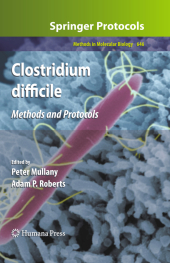 Neuerscheinungen 2016Stand: 2020-02-01 |
Schnellsuche
ISBN/Stichwort/Autor
|
Herderstraße 10
10625 Berlin
Tel.: 030 315 714 16
Fax 030 315 714 14
info@buchspektrum.de |

Peter Mullany, Adam P. Roberts
(Beteiligte)
Clostridium difficile
Methods and Protocols
Herausgegeben von Mullany, Peter; Roberts, Adam P.
Softcover reprint of the original 1st ed. 2010. 2016. x, 241 S. 13 Tabellen. 254 mm
Verlag/Jahr: SPRINGER, BERLIN; HUMANA PRESS 2016
ISBN: 1-493-95701-5 (1493957015)
Neue ISBN: 978-1-493-95701-9 (9781493957019)
Preis und Lieferzeit: Bitte klicken
This book brings together the most recently developed methods for studying clostridium difficile, including techniques involving isolation, molecular typing, genomics, genetic manipulation, and the use of animal models.
Clostridium difficile , a major nosocomial pathogen shown to be a primary cause of antibiotic-associated disease, has emerged as a highly transmissible and frequently antibiotic-resistant organism, causing a considerable burden on health care systems worldwide. In Clostridium difficile: Methods and Protocols , expert researchers bring together the most recently developed methods for studying the organism, including techniques involving isolation, molecular typing, genomics, genetic manipulation, and the use of animal models. Written in the highly successful Methods in Molecular Biology (TM) series format, chapters include brief introductions to their respective topics, lists of the necessary materials and reagents, step-by-step, readily reproducible laboratory protocols, and notes highlighting tips on troubleshooting and avoiding known pitfalls.
Authoritative and cutting-edge, Clostridium difficile: Methods and Protocols serves as an ideal guide for scientists now in a position to gain an in-depth understanding of how this organism is transmitted and how it causes disease.
Part I: Introduction to C. difficile and the Disease It Causes
1. Clostridium difficile: No Longer an Enigmatic Pathogen?
Adam P. Roberts and Peter Mullany
2. Clostridium difficile and the Disease It Causes
Torbjörn Norén
Part II: Isolation and Culture Techniques
3. Clostridium difficile Isolation and Culture Techniques
Mike Wren
Part III: Methods for Typing and Epidemiological Studies
4. Molecular Typing Methods for C. difficile: Pulsed-Field Gel Electrophoresis and PCR Ribotyping
Sandra Janezic and Maja Rupnik
5. Clostridium difficile Toxinotyping
Maja Rupnik
6. Multilocus Sequence Typing for Clostridium difficile
Ludovic Lemée and Jean-Louis Pons
Part IV: Biochemistry of the Organism
7. Molecular Methods to Study Transcriptional Regulation of Clostridium difficile Toxin Genes
Ana Antunes and Bruno Dupuy
8. Dissecting the Cell Surface
Robert Fagan and Neil Fairweather
9. Human Intestinal Epithelial Response(s) to Clostridium difficile
Nazila V. Jafari, Elaine Allan, and Mona Bajaj-Elliott
Part V: Genomics
10. Comparative Genome Analysis of Clostridium difficile Using DNA Microarrays
Richard Stabler, Lisa Dawson, and Brendan Wren
Part VI: Development of Systems for Genetic Analysis of the Organism
11. ClosTron-Targeted Mutagenesis
John T. Heap, Stephen T. Cartman, Sarah A. Kuehne, Clare Cooksley, and Nigel P. Minton
12. Methods for Gene Cloning and Targeted Mutagenesis
Glen P. Carter, Dena Lyras, Rachael Poon, Pauline M. Howarth, and Julian I. Rood
13. Transposon Mutagenesis in C. difficile
Haitham A. Hussain, Adam P. Roberts, Rachael Whalan, and Peter Mullany
Part VII: Animal Models ofDisease
14. Refinement of the Hamster Model of Clostridium difficile Disease
Gillian Douce and David Gouding
15. Methods for Working with the Mouse Model
Anne Collignon


